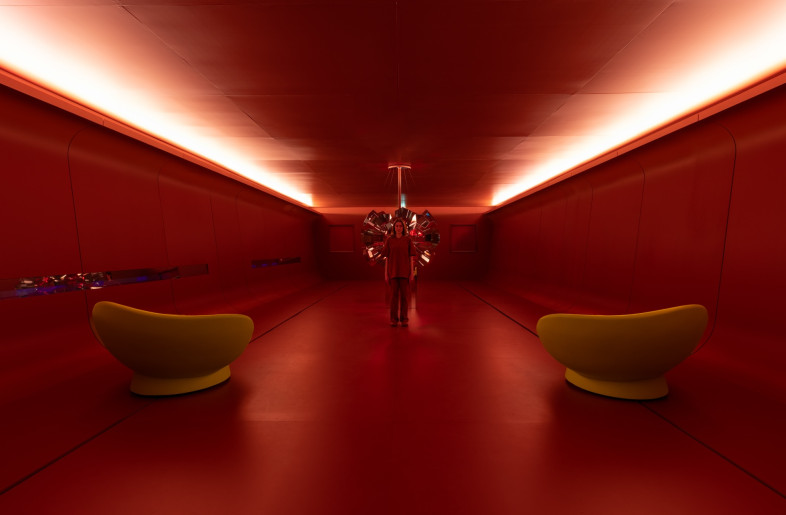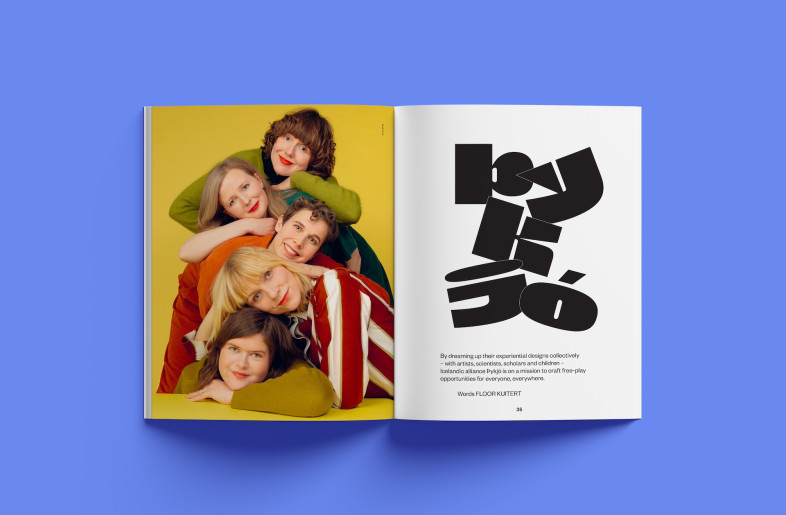Amsterdam-based Italians Andrea Trimarchi and Simone Farresin devote part of every project to intensive research – probing, exploring and analysing the roots of their subject matter. To do so, they assume the role of botanist, historian, scientist, artisan. It’s a lengthy process that’s often based on materials.
Former students at DAE, the pair applied to the school as a duo. Today, it’s their 2009 joint graduation project that Farresin cites as ‘the first time we realized who we were as designers’. Moulding Tradition, a series of ceramic vessels, emerged from research into immigration issues in Caltagirone, a town in Trimarchi’s native Sicily. The project focused on local citizens’ contradictory opinions of the immigration centre there. Unglazed ceramics embellished with Jacquard ribbon, glass and printed paper refer to the Sicilian ceramic tradition of teste di moro – 17th-century vases that portray Moorish faces – and hint at the material awareness and sense of craftsmanship that would become hallmarks of the studio.
2009, Moulding Tradition
Moulding Tradition, Trimarchi and Farresin’s DAE graduation project, hinted at the material awareness and craftsmanship that would become Formafantasma’s modus operandi.
Photo Luisa Zanzani
2011, Botanica
The Botanica collection, a series of vessels based on Formafantasma’s interpretation of polymeric plastic, continued the designers’ research-rich approach to Moulding Tradition.
Photo Luisa Zanzani
The sensitivity to materials and dedication to research expressed in Moulding Tradition didn’t go unnoticed. London gallerist Libby Sellers gave the project a platform at Art Basel, and Plart Foundation founder Maria Pia Incutti also took note.
The Plart Foundation, an institute engaged in the research and technological innovation of plastic objects, commissioned Farresin and Trimarchi to interpret polymeric plastic in their own way. The designers responded by honing in on the moment when plastic was invented. Connecting their process with the current trajectory of plastic in the scientific world allowed them to envision a new aesthetic for the synthetic substance – a shift from pristine finishes to a more artisanal approach. Formafantasma’s Botanica collection is a series of peculiar organic-looking vessels that are difficult to time-stamp.
Since teaming up even before applying to DAE, Trimarchi and Farresin have maintained the dynamic that characterizes their earlier work. Farresin says the long-standing relationship he has with Trimarchi has evolved into an organic way of exploring design together and that much of the work is developed in-house. Today they employ an additional designer and an intern, and call on the expertise of two freelancers when projects warrant it.
2012, Craftica
Working with Fendi on the Craftica project gave the duo the opportunity to learn from the company’s craftspeople and to gain insight into the luxury industry.
Photo Luisa Zanzani
When Fendi came knocking in 2012, asking the men to try their hand at designs for leather, Farresin and Trimarchi delved into the material’s ‘symbolic connotations’. Rather than continuing the relatively scientific approach they had taken to Botanica, they made the ‘complex relationship between humans and nature’ their objective. The opportunity to work with Fendi’s craftspeople gave them an insight into the mind-set of the luxury industry, particularly in terms of the attitude to quality and perfection. ‘There’s a perception that some animals – and therefore certain skins – are more precious than others,’ says Farresin.
To provide an alternative perspective on luxury, Farresin and Trimarchi mapped out various aspects of leather, making a clear connection between the animal and the final product. They combined offcuts from Fendi’s manufacturing process with ‘poor skins’, such as those from fish – deemed as waste by the food industry – and animal bladders. The resulting objects are as diverse in form as they are in material. Stools made from wood, salmon skin, cowhide and sponges sit alongside Bone Jug, a somewhat more graphic translation of the subject: a leather-handled container made of glass blown through a hole in a cow bone.
Fendi was hesitant when viewing Formafantasma’s initial proposals – working with materials like leather and fur requires caution – but the company welcomed the outcome. Craftica wasn’t about criticizing the use of leather, says Farresin, but about demonstrating what already exists, and, in this case, challenging ideas of perfection and quality. ‘It’s a component of our work,’ he says, ‘the distinctive need to discard cliché.’
2014, De Natura Fossilium
Formafantasma teamed up with cultural institutions to develop De Natura Fossilium, highlighting the studio’s dedication to serious research.
Photo Luisa Zanzani
Harking back to their graduation project and to the relationship forged with Libby Sellers, Farresin and Trimarchi began another Sicily-centric investigation in 2014. Concentrating on Mount Etna and the island of Stromboli, the designers saw potential in the sites, both steeped in local industry and tourism, as ‘ground zeros for production’.
Opting for lava as a material, they began experimenting in their studio, situated in Eindhoven at the time, before conducting further studies on what was to become De Natura Fossilium. ‘Our process can be intuitive and childlike, but there comes a point at which we do proper research,’ says Farresin. The pieces in Formafantasma’s 2014 collection were an amalgamation of skill sets, makers and nationalities. The 1892 Stool, for example, contains brass cast by Viennese metalworker Carl Auböck II; occhio di pernice, basalt lava sourced from Etna; and lava glass provided by Eindhoven-based workshop Beeldenstorm, the National Glass Museum in Leerdam, and Murano. The fabric element was created in the Tilburg Textile Museum. It’s notable that the parties involved aren’t simple production companies, but historically important institutions whose values resonate with those that Formafantasma so often imbues in its work.
In much the same way as they stuffed their pockets full of lava and returned to Eindhoven to test their ideas, Trimarchi and Farresin used the project to address – and shed light on – the concerns and issues that afflict Sicilian society. Farresin says the idea was not to take the work out of its context, but to seize the ‘opportunity to present local concerns at a global level’. In 2009, Moulding Tradition highlighted an arguably local issue; five years later, De Natura Fossilium invited outsiders to look in.
2016, Anno Tropico
Anno Tropico marked a shift from the handcrafted object to a more industrialized product – albeit with a similar, conceptually rooted approach to design.
Photo Laura Fantacuzzi and Maxime Galati-Fourcade
Unveiled at the Peep-Hole gallery in Milan, Formafantasma’s latest exhibition, Anno Tropico, saw the studio’s craft sensibilities take a distinctly industrial turn. Instead of probing the potential of traditional leather or ceramic work, Farresin and Trimarchi adopted light as their material, assessing the ‘relationship between natural and artificial illumination’. Although Anno Tropico may mark a shift in aesthetic and material, ‘the approach is the same’, says Farresin. Despite the technical expertise required for lighting design, Anno Tropico was produced at the studio. Not designed to simply stand alone, the pieces are subtle architectural inventions. The decision to make them site-specific came naturally: ‘The light is overwhelming in the Peep-Hole gallery; we couldn’t not react to it.’
The studio was approached prior to the exhibition by a manufacturer of industrial lighting, a field the designers had already explored as an area of interest. What could be seen as a new direction for Formafantasma seems more like a natural progression – one in which timing and partner compatibility are crucial. As Farresin says: ‘In work, you need to find a soulmate.’
Portrait Winter Vandenbrink
formafantasma.com
Read more interviews with industry leaders in the July/August 2016 issue. Find Frame #111 in the Frame store.










